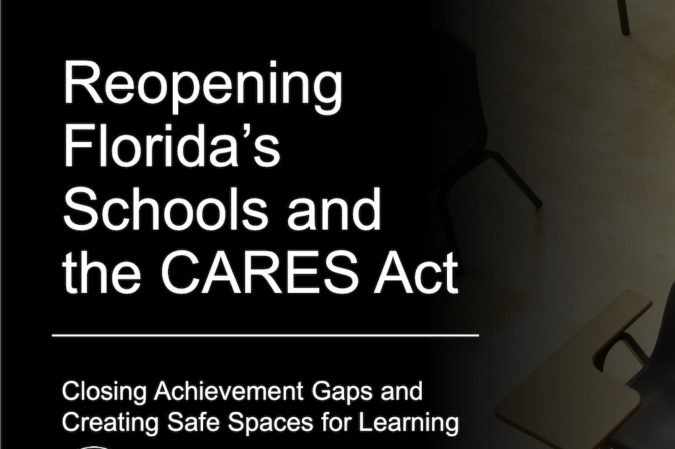
Today is the deadline for parents in Escambia to notify the school district whether their children will attend school, take classes online or will be enrolled in the Escambia Virtual Academy.
For some reason, Superintendent Malcolm Thomas has not made available to parents and school board members the Florida Department of Education’s Reopening  & Cares Act plan that was sent out on June 10 .
The document is described  as a guide with recommendations, a resource and framework for local decision making and one that  is intended to be updated and changed as the context evolves.
Some of the recommendations have made it into the school district’s reopening plan according to the district’s website. Parents should review FDOE document to hold the school district accountable.
FDOE recommends the school district should create a Crisis Response Team that  should coordinate with local health departments and medical experts, to establish protocols for direct supports and communications.
School nurses or other school health staff should serve as liaisons with the county department of health and medical experts.
The challenge for Escambia County is the district has outsourced school health and not all schools have full-time nurses.
Inweekly received a copy of the FDOE document last night. Here are some of the highlights:
Face Coverings
While cloth face coverings are not mandated, schools should explore strategies to utilize them, to the extent feasible.
ô°€
At a minimum, schools should be supportive of students, teachers and staff who voluntarily wear cloth face coverings.
As feasible, cloth face coverings can be an important mitigation tool for individuals and families when not able to maintain social distancing for activities such as:
ô°€
- Busing and transportation;
- Events and meetings;
- ô°€ Courses that necessitate close proximity;
- ô°€ Educating medically vulnerable students;
- ô°€ Supporting medically vulnerable staff; and
- ô°€ Protecting schools’ health care workers and crisis responders.
Educational programs should be mindful that young children may initially fear individuals wearing a face covering, and therefore should consider ways to gently introduce the idea.
Districts and schools should explore the use of cloth face coverings on school buses.
Medically Vulnerable
1) Medically vulnerable students should develop a plan for returning to school with their family doctor.
a) School health staff should develop school health comprehensive care plans in consultation with the county health department. Schools could consider accommodations on a case-by-case basis, and consider clustering these students away from other students, in smaller settings, with a teacher who is wearing a cloth face covering.
2) Medically vulnerable staff should also work with their doctors to create a return to work plan.
a)Whenever feasible for medically vulnerable staff, steps should be taken to minimize the number of people they interact with, and districts and institutions should consider flexible leave policies.
3) The same guidelines apply for students and staff who live with medically vulnerable family members.
Recommendations to Reduce Risks at the Front Door
- Create a crisis response team at the district, school or program level, as applicable.
- Post a crisis plan and response check list where they are easily accessible.
- Consider screening students, employees and visitors through visual signage, verbal questions or visual assessments.
- As feasible and while maintaining the goal of getting students on campus every day, explore staggered schedules, start and end times to limit crowds.
- Monitor student and employee absenteeism closely, as absenteeism may be an early warning system of larger health concerns.
- Regularly update employees, parents and students with emails on best practices for at-home preventative care.
- Locally determine what constitutes an adequate prevention inventory that includes extra supplies of PPE, cloth face coverings, gloves, sanitizer, soap, etc.
- Consider creating a protocol for incoming and outgoing mail and deliveries, and consider creating a “timeout†or cleansing room.
- Post signage about hygiene and social distancing in many very accessible areas.
- Conduct employee trainings for all of the above and regular employee meetings on COVID-19 updates.
Recommendations to Redesign the School Day to Reduce Risks
- As feasible, keep groups of students together throughout the day to minimize the number of people in close contact with each person.
- As feasible, convert cafeterias, libraries, gymnasiums, auditoriums, outdoor areas into classroom space.
- Explore allowing students to eat meals in traditional classroom space or outdoors.
- Move nonessential furniture and equipment out of classrooms to increase distance between students and turn desks the same direction.
- Maintain a maximum distance between desks as possible, even if not able to achieve 6 feet, and avoid sharing of textbooks, supplies and toys.
- Consider setting up a secondary clinic in schools, exclusively for students showing symptoms of COVID-19.
- Establish procedures in consultation with school health staff to quickly separate students and staff who become sick from others.
- Create a disinfection protocol for cleaning door knobs, counters and other surfaces throughout the day.
- Consider limiting nonessential visitors to campuses and programs.
- Consider alternative meeting options for nonessential volunteer activities, clubs and other elective meetings that require in-person contact.
- Explore limiting nonessential mass gatherings or reschedule as virtual gatherings.
Recommendations to Plan for Graduations, Sports, Band, Arts, Other Extracurriculars and Co-curriculars
- Consult with the local department of health and the crisis response team.
- Florida’s K-12 schools should proactively plan to safely conduct extracurriculars and co-curriculars, including graduations, sports, and other close contact events and gatherings.
- At events, consider non-contact temperature testing of adults who will be direct participants and have close contact with students.
- Monitor students who participate in extracurriculars for symptoms throughout the day.
- All equipment, instruments, uniforms, etc. should be washed or wiped down after each use.
- Explore an increased presence of law enforcement or staff at events to maintain adherence to social distancing.
- Consider limited seating at events while allowing families to sit together and marking off seating for social distancing.
- Consider having attendees arrive at events earlier, stagger exits and allow for multiple entry and exit points.
- Explore options to maintain social distancing at event facilities: public restrooms, concessions, etc.
- Consider ways to limit close contact between participants and attendees until an event concludes.
- Identify a space that can be used to isolate staff or participants if one becomes ill at an event.
- Determine what are adequate prevention supplies to have at an event for participants and attendees, including hand sanitizing stations.



